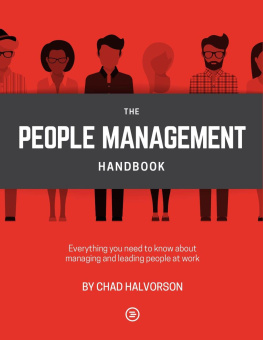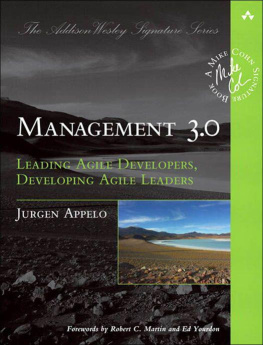
2019 ASTD DBA the Association for Talent Development (ATD)
All rights reserved. Printed in the United States of America.
22 21 20 19 1 2 3 4 5
No part of this publication may be reproduced, distributed, or transmitted in any form or by any means, including photocopying, recording, information storage and retrieval systems, or other electronic or mechanical methods, without the prior written permission of the publisher, except in the case of brief quotations embodied in critical reviews and certain other noncommercial uses permitted by copyright law. For permission requests, please go to www.copyright.com, or contact Copyright Clearance Center (CCC), 222 Rosewood Drive, Danvers, MA 01923 (telephone: 978.750.8400; fax: 978.646.8600).
ATD Press is an internationally renowned source of insightful and practical information on talent development, training, and professional development.
The sections describing the Bridges Model in step 9 are adapted from Haneberg, L. 2005. Organization Development Basics. Alexandria, VA: ASTD Press, 58-60.
ATD Press
1640 King Street
Alexandria, VA 22314 USA
Ordering information: Books published by ATD Press can be purchased by visiting ATDs website at www.td.org/books or by calling 800.628.2783 or 703.683.8100.
Library of Congress Control Number: 2019933794
ISBN-10: 1-949036-20-0
ISBN-13: 978-1-949036-20-6
e-ISBN: 978-1-949036-21-3
ATD Press Editorial Staff
Director: Kristine Luecker
Manager: Melissa Jones
Community of Practice Manager, Management: Ryan Changcoco
Developmental Editor: Kathryn Stafford
Text and Cover Design: Darrin Raaum
Printed by P.A. Hutchison Company, Mayfield, PA
Introduction
Management is the engine that drives our corporations. It ensuresor preventsthe daily completion of work and overall strategic implementation. This may sound very things oriented, but make no mistake; management is a people-driven job. Our organizations need managers who bring individuals and teams together such that they do their best work in the service of company goals. Its tough to be a great manager, but its also fascinating, enriching, meaningful, and fun. And never boring when done well! Unfortunately, some managers struggle to succeed because they let barriers like these get in their way:
They become a victim of circumstances. Managers are needed to improve the organization and its results, but corporate dysfunction or immaturity can seem overwhelming. It is important to own your role in making things better and to resist becoming part of the problem.
They confuse the need to manage with the need to control. Some managers think that their job is to control people and operations. Control is a myth; you cant and should not try to control people. The managers job is to ensure that people and processes are doing their very best work toward achieving the goals of the enterprise. To do this, managers must connect to and relate with people and enliven their motivation. Actions that attempt to control people move results in the opposite direction. Great management is focused, service oriented, and relationship driven.
They let management become maintenance. It is the managers responsibility to make something happen that would not have happened without them. Management should never turn into maintenance. If you are doing the same things every day and spending most of your time maintaining your piece of the business, you are not actively managing. Its easy to fall into the trap of getting comfortable with success, but managers need to resist this urge and ensure that they continue to drive performance forward.
They fail to tune up and realign. Management A produces Results A. If you want Results B, you cannot get there using Management A. Great managers periodically tune and align their practices and approaches to produce desired results. Corporate strategies, initiatives, and goals frequently change, requiring managers to change too.
Do you struggle with any of these barriers or others? Please dont get discouraged; nearly every manager Ive met has, at some point in their career, been challenged by the cruddy bits of management. The good news is that you can reduce these and other daily pain points by consistently applying best practices for management like the ones I share in this book. You have the opportunity to make a significant impact on the business and your team members lives. Youll need to blast through organizational politics and dysfunction. But thats why youre here! Embrace the challenge and triumph over management barriers. Make this the best job you will ever have.
Management and Leadership
Before I get into the specifics of the 10 steps, I want to address a common question: Whats the difference between management and leadership? My perspective on this may differ from what youve heard before or read in books about leadership. First, I dont believe that management and leadership are different positions or jobs. Many companies distinguish managers and leaders based on their pecking order in the organization. That seems like nonsense to me. We see and experience leadership at all levels of the organization. Some people believe that leadership is something you do when you move beyond managementthat leadership is a set of higher-level tasks and that it takes more skill to be a leader than it does to be a manager. This belief does not make sense either. In fact, people with all ranges of education and sophistication and at all organization levels can and do demonstrate leadership.
So lets draw the distinction. Management is a set of methods and practicesa regimenthat enables us to run a business or a piece of the business. Its a job. Leadership is not a job; its the way we do the job.
Imagine four peer managers sitting in a meeting together discussing the progress of a major project. The discussion itself could be considered part of managementits part of the process. Having update meetings about major initiatives is a management task. Lets say that one of those managers, you, demonstrates courage and initiates a frank discussion about concerns that the others are too chicken to bring up. At your prompting, the discussion addresses important issues that need to be defined and resolved. During that display of couragein that moment while the four of you were managingyou demonstrated leadership.
We ought to be managers all the time and show leadership when its needed. If you are an operations manager, you ought to be a great operations manager all the time and demonstrate leadership when the situation calls for it. The same is true at all levels of the organization. Frontline workers ought to be great frontline workers all the time and lead when necessary.
The 10 steps offered in this book fall into the category of good management practices. Along the way, Ill share examples of where and when leadershipthe way you approach your work and relationshipswill help you improve momentum and connectedness. To be most successful in a management job, youll also demonstrate leadership.
Whats New in the Second Edition? Alignment With the ACCEL Model
In 2015 and 2016, the Association for Talent Development (ATD) conducted survey-based research to determine the crucial skills for managerial success. They then outlined the top five skillsaccountability, collaboration, communication, engagement, and listening and assessingin the report










